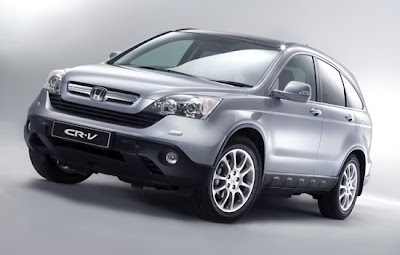Honda CR-V
Honda CR-V
The 2012 Honda CR-V styling will have to abandon the impassive look of the third-generation Honda CR-V and become more expressive if Honda wants it to look fashionable next to flamboyant newcomers like the recently redesigned 2011 Hyundai Tucson and 2011 Kia Sportage and the all-new 2012 Ford Escape. The vast majority of Honda CR-Vs sold in the U.S. are assembled at Honda’s plant in Ohio, but this
crossover is marketed in some 160 countries and the fourth-generation’s styling is likely to take inspiration from the animated shapes of Hondas sold in Europe and Asia. Honda would be wise to not sacrifice interior roominess in the name of swoopy styling, however. It should not abandon the packaging acumen it demonstrated with the 2007-2011 Honda CR-V, which had mid-pack exterior dimensions but an airy cabin and a cargo hold that were among the most spacious in the class. By sharing Civic’s platform, the 2012 Honda CR-Vwill continue to qualify as a crossover. Crossovers combine an elevated, SUV-like body with a car-type understructure. This one-piece “unibody” construction is in contrast to pickups and older-style SUVs that employ truck-type engineering in which the body is attached to a separate frame. Unibody design isn’t as suited to heavy-duty hauling, but its lighter weight benefits ride, handling, and fuel economy. Note that the Acura RDX compact crossover from Honda’s premium division also shares Honda CR-V’s basic unibody structure, though it has different styling and a more powerful engine.
Honda CR-V
Honda CR-V
The 2012 Honda CR-V also could benefit from a new philosophy toward features. Not that it’ll lack the most popular basics: In Honda CR-V such amenities as a navigation system, Bluetooth hands-free cell-phone connectivity, USB iPod interface, leather upholstery, automatic dual-zone climate control, power moonroof, heated front seats, and a backup camera will return. But Honda needs to reassess a policy that reserves many of these features for the most expensive models in the Honda CR-Vlineup. The competition’s egalitarian approach is a selling point, and the trend is to make features such as USB linking standard and a navigation system optional on even entry-level models. Honda ought also to consider filtering into the Honda CR-V such gee-whiz technology as lane-departure-warning, adaptive cruise control, even automatic parallel-parking. These have been the province of premium brands, but a few mid-priced crossovers are beginning to offer them, and more will follow as buyers reorient to smaller cars and SUVs but refuse to lower expectations about available features. To Honda’s credit, it’s never skimped on Honda CR-V safety, and the 2012 model will continue standard with such vitals as an antiskid system to combat sideways slides. Hopefully, Honda won’t backslide on the 2012 Honda CR-V’s cabin design and décor, either. This SUV’s always been a benchmark for high-quality interior materials, seat comfort, and ergonomics.
courtesy by http://iguida.com/2012-honda-cr-v





















No comments:
Post a Comment